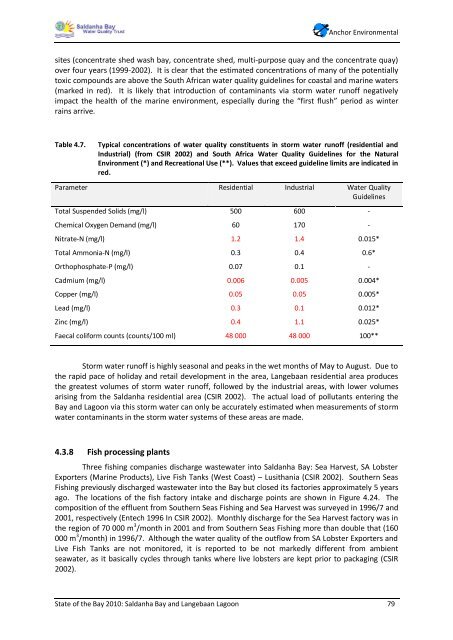State of the Bay Report 2010-Final - Anchor Environmental
State of the Bay Report 2010-Final - Anchor Environmental
State of the Bay Report 2010-Final - Anchor Environmental
You also want an ePaper? Increase the reach of your titles
YUMPU automatically turns print PDFs into web optimized ePapers that Google loves.
<strong>Anchor</strong> <strong>Environmental</strong><br />
sites (concentrate shed wash bay, concentrate shed, multi-purpose quay and <strong>the</strong> concentrate quay)<br />
over four years (1999-2002). It is clear that <strong>the</strong> estimated concentrations <strong>of</strong> many <strong>of</strong> <strong>the</strong> potentially<br />
toxic compounds are above <strong>the</strong> South African water quality guidelines for coastal and marine waters<br />
(marked in red). It is likely that introduction <strong>of</strong> contaminants via storm water run<strong>of</strong>f negatively<br />
impact <strong>the</strong> health <strong>of</strong> <strong>the</strong> marine environment, especially during <strong>the</strong> “first flush” period as winter<br />
rains arrive.<br />
Table 4.7. Typical concentrations <strong>of</strong> water quality constituents in storm water run<strong>of</strong>f (residential and<br />
Industrial) (from CSIR 2002) and South Africa Water Quality Guidelines for <strong>the</strong> Natural<br />
Environment (*) and Recreational Use (**). Values that exceed guideline limits are indicated in<br />
red.<br />
Parameter Residential Industrial Water Quality<br />
Guidelines<br />
Total Suspended Solids (mg/l) 500 600 -<br />
Chemical Oxygen Demand (mg/l) 60 170 -<br />
Nitrate-N (mg/l) 1.2 1.4 0.015*<br />
Total Ammonia-N (mg/l) 0.3 0.4 0.6*<br />
Orthophosphate-P (mg/l) 0.07 0.1 -<br />
Cadmium (mg/l) 0.006 0.005 0.004*<br />
Copper (mg/l) 0.05 0.05 0.005*<br />
Lead (mg/l) 0.3 0.1 0.012*<br />
Zinc (mg/l) 0.4 1.1 0.025*<br />
Faecal coliform counts (counts/100 ml) 48 000 48 000 100**<br />
Storm water run<strong>of</strong>f is highly seasonal and peaks in <strong>the</strong> wet months <strong>of</strong> May to August. Due to<br />
<strong>the</strong> rapid pace <strong>of</strong> holiday and retail development in <strong>the</strong> area, Langebaan residential area produces<br />
<strong>the</strong> greatest volumes <strong>of</strong> storm water run<strong>of</strong>f, followed by <strong>the</strong> industrial areas, with lower volumes<br />
arising from <strong>the</strong> Saldanha residential area (CSIR 2002). The actual load <strong>of</strong> pollutants entering <strong>the</strong><br />
<strong>Bay</strong> and Lagoon via this storm water can only be accurately estimated when measurements <strong>of</strong> storm<br />
water contaminants in <strong>the</strong> storm water systems <strong>of</strong> <strong>the</strong>se areas are made.<br />
4.3.8 Fish processing plants<br />
Three fishing companies discharge wastewater into Saldanha <strong>Bay</strong>: Sea Harvest, SA Lobster<br />
Exporters (Marine Products), Live Fish Tanks (West Coast) – Lusithania (CSIR 2002). Sou<strong>the</strong>rn Seas<br />
Fishing previously discharged wastewater into <strong>the</strong> <strong>Bay</strong> but closed its factories approximately 5 years<br />
ago. The locations <strong>of</strong> <strong>the</strong> fish factory intake and discharge points are shown in Figure 4.24. The<br />
composition <strong>of</strong> <strong>the</strong> effluent from Sou<strong>the</strong>rn Seas Fishing and Sea Harvest was surveyed in 1996/7 and<br />
2001, respectively (Entech 1996 In CSIR 2002). Monthly discharge for <strong>the</strong> Sea Harvest factory was in<br />
<strong>the</strong> region <strong>of</strong> 70 000 m 3 /month in 2001 and from Sou<strong>the</strong>rn Seas Fishing more than double that (160<br />
000 m 3 /month) in 1996/7. Although <strong>the</strong> water quality <strong>of</strong> <strong>the</strong> outflow from SA Lobster Exporters and<br />
Live Fish Tanks are not monitored, it is reported to be not markedly different from ambient<br />
seawater, as it basically cycles through tanks where live lobsters are kept prior to packaging (CSIR<br />
2002).<br />
<strong>State</strong> <strong>of</strong> <strong>the</strong> <strong>Bay</strong> <strong>2010</strong>: Saldanha <strong>Bay</strong> and Langebaan Lagoon 79

















